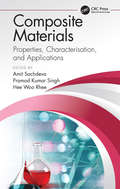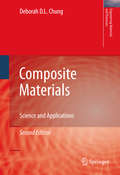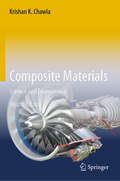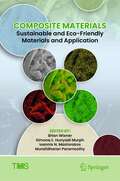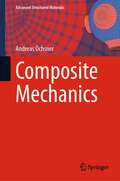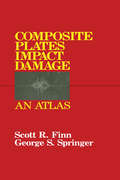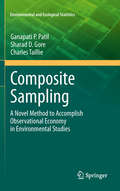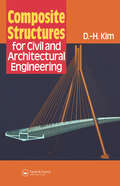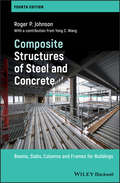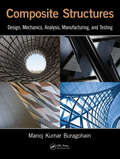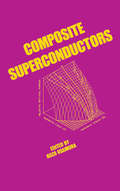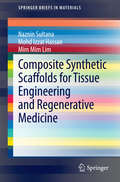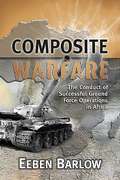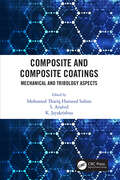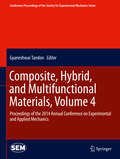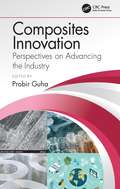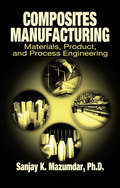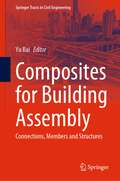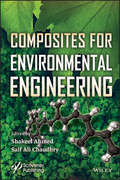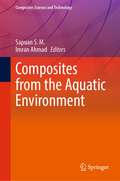- Table View
- List View
Composite Materials: Mechanics, Manufacturing and Modeling
by Sumit SharmaComposite materials find diverse applications in areas including aerospace, automotive, architecture, energy, marine and military. This comprehensive textbook discusses three important aspects including manufacturing, mechanics and dynamic mechanical analysis of composites. The textbook comprehensively presents fundamental concepts of composites, manufacturing techniques and advanced topics including as advances in composite materials in various fields, viscoelastic behavior of composites, toughness of composites and Nano mechanics of composites in a single volume. Topics such as polymer matrix composites, metal matrix composites, ceramic matrix composites, micromechanical behavior of a lamina, micromechanics and nanomechanics are discussed in detail. Aimed at senior undergraduate and graduate students for a course on composite materials in the fields of mechanical engineering, automobile engineering and electronics engineering, this book: Discusses mechanics and manufacturing techniques of composite materials in a single volume. Explains viscoelastic behavior of composites in a comprehensive manner. Covers fatigue, creep and effect of thermal stresses on composites. Discusses concepts including bending, buckling and vibration of laminated plates in detail. Explains dynamic mechanical analysis (DMA) of composites.
Composite Materials: Properties, Characterisation, and Applications
by Pramod Kumar Singh Amit Sachdeva Hee Woo RheeComposite Materials: Properties, Characterisation, and Applications provides an in-depth description of the synthesis, properties, and various characterisation techniques used for the study of composite materials. Covers applications and simulation tests of these advanced materials Presents real-world examples for demonstration Discusses surface, thermal, and electrical characterisation techniques Covers composites for use as sensors Aimed at industry professionals and researchers, this book offers readers thorough knowledge of the fundamentals as well as advanced level techniques involved in composite material characterisation, development, and applications.
Composite Materials: Science and Applications (Engineering Materials and Processes)
by Deborah D. ChungThe first edition of "Composite Materials" introduced a new way of looking at composite materials: covering composites in accordance with their functions. This second edition expands the book's scope to emphasize application-driven and process-oriented materials development. This tutorial-style reference book examines both structural composite materials and functional composite materials, as needed for a substantial range of applications. The emphasis on application-driven and process-oriented materials development is enhanced by a large amount of experimental results that provide real illustrations of composite materials development. "Composite Materials" is an essential book for researchers and engineers who are interested in materials development for industrial applications. It has a vibrant yet functional approach, making it suitable for both students and practitioners, and provides a full explanation of all of the fundamental concepts related to the structural and functional properties covered.
Composite Materials: Science and Engineering (Materials Research And Engineering Ser.)
by Krishan K. ChawlaThe fourth edition of Krishan Chawla's widely used textbook, Composite Materials, offers integrated and completely up-to-date coverage of composite materials. The book focuses on the triad of processing, structure, and properties, while providing a well-balanced treatment of the materials science and mechanics of composites. In this edition of Composite Materials, revised and updated throughout, increasing use of composites in industry (especially aerospace and energy) and new developments in the field are highlighted. New material on the advances in non-conventional composites (which covers polymer, metal and ceramic matrix nanocomposites), self-healing composites, self-reinforced composites, biocomposites and laminates made of metals and polymer matrix composites is included. Examples of practical applications in various fields are provided throughout the book, with extensive references to the literature. The book is intended for use in graduate and upper-division undergraduate courses and as a reference for the practicing engineers and researchers in industry and academia.
Composite Materials: Sustainable and Eco-Friendly Materials and Application (The Minerals, Metals & Materials Series)
by Simona E. Hunyadi Murph Brian Wisner Ioannis N. Mastorakos Muralidharan ParamsothyThis collection covers innovations in the field of composite materials with a specific focus on eco-friendly and environmentally sustainable systems. All composite fields are explored, including polymer, metal, and ceramic matrix composites with an emphasis on sourcing raw materials in a sustainable way as well as the development of composite materials for environmental sustainability. Topics will include the development of new materials for structural applications, reduction in energy consumption, and increased component life along with discussions of novel methods to reuse existing materials. Additional topics include, but are not limited to:· Naturally Sourced Materials feedstock · Recycled Material feedstock, · Application of composite for reduced carbon footprint · Development of novel materials to repurpose waste from other areas
Composite Mechanics (Advanced Structured Materials #184)
by Andreas ÖchsnerThis book in the advanced structured materials series provides first an introduction to the mircomechanics of fiber-reinforced laminae, which deals with the prediction of the macroscopic mechanical lamina properties based on the mechanical properties of the constituents, i.e., fibers and matrix. Composite materials, especially fiber-reinforced composites, are gaining increasing importance since they can overcome the limits of many structures based on classical metals. Particularly, the combination of a matrix with fibers provides far better properties than the constituents alone. Despite their importance, many engineering degree programs do not treat the mechanical behavior of this class of advanced structured materials in detail, at least on the bachelor’s degree level. Thus, some engineers are not able to thoroughly apply and introduce these modern engineering materials in their design process. The second part of this book provides a systematic and thorough introduction to the classical laminate theory based on the theory for plane elasticity elements and classical (shear-rigid) plate elements. The focus is on unidirectional lamina which can be described based on orthotropic constitutive equations and their composition to layered laminates. In addition to the elastic behavior, failure is investigated based on the maximum stress, maximum strain, Tsai-Hill, and the Tsai-Wu criteria. The introduced classical laminate theory provides a simplified stress analysis, and a subsequent failure analysis, without the solution of the system of coupled differential equations for the unknown displacements in the three coordinate directions. The book concludes with a short introduction to a calculation program, the so-called Composite Laminate Analysis Tool (CLAT), which allows the application of the classical laminate based on a sophisticated Python script.
Composite Plates Impact Damage: An Atlas
by ScottR. FinnThis is a unique X-ray atlas illustrating damage in composite plates caused by non-penetrating impacts. A valuable aid in designing composites for different types of impact resistance. Damage to composite materials caused by non-penetrating impact is often internal, invisible and difficult to detect. This atlas contains more than 400 revealing pictures of impact damage from a variety of loads under a variety of conditions. The parameters are varied systematically to produce useful, reliable design data.
Composite Sampling: A Novel Method to Accomplish Observational Economy in Environmental Studies (Environmental and Ecological Statistics #4)
by Sharad D. Gore Ganapati P. Patil Charles TaillieSampling consists of selection, acquisition, and quantification of a part of the population. While selection and acquisition apply to physical sampling units of the population, quantification pertains only to the variable of interest, which is a particular characteristic of the sampling units. A sampling procedure is expected to provide a sample that is representative with respect to some specified criteria. Composite sampling, under idealized conditions, incurs no loss of information for estimating the population means. But an important limitation to the method has been the loss of information on individual sample values, such as, the extremely large value. In many of the situations where individual sample values are of interest or concern, composite sampling methods can be suitably modified to retrieve the information on individual sample values that may be lost due to compositing. This book presents statistical solutions to issues that arise in the context of applications of composite sampling.
Composite Steel Structures: Advances, design and construction
by R. NarayananThe constant need for cost-effective structural forms has led to the increasing use of composite construction, and a substantial amount of research effort is currently being spent in developing techniques for combining concrete and steel effectively. Significant economies in this form of construction have been observed, especially in bridges and building floors. Codes of Practice on composite construction are being revised in the UK and in Europe, in the light of the substantial amount of knowledge that has been generated in recent years. An International Conference organised by the Department of Civil and Structural Engineering, University College, Cardiff, UK, with the specific objective of discussing all types of metal structures in an integrated way, provided a forum for the dissemination of new concepts and for reviewing developments; the expectations of the organisers have been amply justified and exceeded by the level of international response to the call for papers. This volume contains 17 papers on composite steel structures, presented at the Conference, many of which were by well-known experts in their respective fields.
Composite Steel Structures: Recent research and developments
by S L Lee N E ShanmugamProceedings of the International Conference on Steel and Aluminium Strucutres, ICSAS 91, Singapore 22-24 May 1991. The complete proceedings are available in three volumes: steel structures, aluminium structures and composite steel structures.The conference was organised by the Department of Civil Engineering, National University of Singapore sequel to the one held in Cardiff, UK in July 1987. It was co-sponsored by the International Association for Bridge and Structural Engineering, the Institution of Civil Engineers, the Institution of Engineers, Singapore, the Institution of Structural Engineers, the Steel Construction Institute, UK, the Singapore Structural Steel Society and the University of Wales College of Cardiff. The conference provided a forum to discuss recent advances and trends in the analysis, design and construction of all types of metal structures.This volume contains 18 of the papers presented at the conference. Invited Lectures on the state-of-the-art surveys have been provided by well-known experts in their respective fields. The coverage is extensive and topics include Bridges, Building Floor Systems, Concrete Filled Hollow Sections, Aluminium-concrete Systems, Composite Members to Earthquake Loading, etc.
Composite Structures for Civil and Architectural Engineering (Structural Engineering: Mechanics and Design)
by D-H KimA thorough and understandable guide to the properties and design of structural composites. It derives from the author's many years of experience of research, industrial development and teaching.
Composite Structures of Steel and Concrete: Beams, Slabs, Columns and Frames for Buildings
by Roger P. JohnsonThis book provides an introduction to the theory and design of composite structures of steel and concrete. Material applicable to both buildings and bridges is included, with more detailed information relating to structures for buildings. Throughout, the design methods are illustrated by calculations in accordance with the Eurocode for composite structures, EN 1994, Part 1-1, ‘General rules and rules for buildings’ and Part 1-2, ‘Structural fire design’, and their cross-references to ENs 1990 to 1993. The methods are stated and explained, so that no reference to Eurocodes is needed. The use of Eurocodes has been required in the UK since 2010 for building and bridge structures that are publicly funded. Their first major revision began in 2015, with the new versions due in the early 2020s. Both authors are involved in the work on Eurocode 4. They explain the expected additions and changes, and their effect in the worked examples for a multi-storey framed structure for a building, including resistance to fire. The book will be of interest to undergraduate and postgraduate students, their lecturers and supervisors, and to practising engineers seeking familiarity with composite structures, the Eurocodes, and their ongoing revision.
Composite Structures: Design, Mechanics, Analysis, Manufacturing, and Testing
by Manoj Kumar BuragohainThe primary objective of this book is to bridge this gap by presenting the concepts in composites in an integrated and balanced manner and expose the reader to the total gamut of activities involved in composite product development. It includes the complete know-how for development of a composite product including its design & analysis, manufacture and characterization, and testing. <P><P>The book has fourteen chapters that are divided into two parts with part one describing mechanics, analytical methods in composites and basic finite element procedure, and the second part illustratesr materials, manufacturing methods, destructive and non-destructive tests and design.
Composite Structures: Effects of Defects
by Rani Elhajjar Peter N. Grant Cindy AshforthPresents the latest strategies in the development and use of composite materials for large structures and the effects of defects Practical Design and Validation of Composites Structures: Effects of Defects offers an important guide to the use of fiber-reinforced composites and how they affect the durability and safety of engineering structures such as aircraft, ships, bridges, wind turbines as well as sporting equipment. The text draws on the authors’ direct experience in industry and academia to cover the most recent strategies in the development of composite structures and uniquely integrates the assessment of the effects of defects introduced during production. This comprehensive resource builds on an essential introduction to the characteristics of composites and the most common types of defects encountered in production. The authors review the recent manufacturing methods and technologies used for inspecting composite structures and the design issues related to an analysis of their failure and strength incorporating the variability of processing. The text also contains information on the latest regulatory requirements and the relevant standards associated with the testing and design within a robust design philosophy and approach. This important resource: Offers a comprehensive review of the most current regulatory developments in the use of composites for the construction of complex composite structures Presents information on the basic characteristics of composites Includes testing strategies for determining the impacts of production defects Reviews the most current manufacturing methods and inspection technologies in the field Contains methods for statistical analysis and processing of experimental effects of defects test data Written for professional engineers in mechanical engineering, automotive engineering, aerospace engineering, civil engineering, and energy engineering as well as industry and academic researchers, Practical Design and Validation of Composites Structures: Effects of Defects is the hands-on text that covers the essential information needed to understand the use of composites and how they affect complex engineering projects using composites.
Composite Superconductors (Applied Physics Ser.)
by K. OsamuraThis reference examines the tremendous benefits produced by the use of superconductivity, including the realization of a commercial fusion reactor for the generation of electricity. Providing a comprehensive coverage of superconductivity and magnet design - incorporating background information for beginners as well as research advances for specialists - this work: discusses the historical development of superconductivity and its engineering applications; explains the mechanical properties of the metal matrix composite; describes the important electromagnetic factors for the design of composite superconductors; analyzes the fabrication and optimization of various composite superconductors; and assesses the future development of high Tc oxide superconductors for engineering applicaitons.;This title is intended for: physicists; metallurgists; materials scientists; materials, electrical, mechanical, cryogenic and medical engineers; and graduate students in these disciplines.
Composite Synthetic Scaffolds for Tissue Engineering and Regenerative Medicine (SpringerBriefs in Materials)
by Naznin Sultana Mohd Izzat Hassan Mim Mim LimThis book addresses important biomaterials which are commonly used to fabricate scaffolds and it describes two major protocols employed in scaffold fabrication. Tissue engineering or regenerative medicine aims at restoring ex-novo tissues and organs whose functionality has been compromised as a consequence of diseases or traumatic events. The innovative concept underlying tissue engineering is the use of autologous cells, obtained from a biopsy of the patient. Cells are seeded on a porous scaffold which has the role of supporting and guiding cells towards the development of tissue-like structures as well as providing a platform for the delivery under controlled condition of growth factor release, etc. The successful manufacture of scaffolds for tissue engineering applications is crucial. In this book, these biomaterials are discussed. The book also covers illustrated examples, structure and properties of scaffolds, cellular interactions and drug delivery.
Composite Warfare: The Conduct Of Successful Ground Force Operations In Africa
by Eeben BarlowComposite Warfare presents African soldiers and scholars with a true African ‘Art of War’. As a continent, Africa presents her armies with a vast, dynamic and multidimensional operating environment. It has numerous complex and diverse ethnic, religious, cultural and tribal interests and loyalties, along with many multifaceted threat-drivers coupled to varied and infrastructure-poor terrain plus vast climatic variations. The continent is, furthermore, characterized by numerous half-won conflicts and wars fought by incorrectly structured, inadequately trained and ill-equipped armies. For many reasons, these forces have difficulty adapting to the complex, demanding and rapidly changing environments they do battle in. Similarly, the armies have difficulty in decisively defeating the various threats they face. Many of these problems stem from the fact that numerous modern-day African armies are merely clones of the armies established by their once-colonial masters, their Cold War allies or their new international allies. Many of the principles and tactics, techniques and procedures they were – and still are – being taught relate to fighting in Europe and not in Africa. Some of these concepts are not even relevant to Africa. This book is intended as a guide and textbook for African soldiers and scholars who wish to understand the development of hostilities, strategy, operational design, doctrine and tactics. It also illustrates the importance of nonpartisanship and the mission and role of the armed forces. Officers, NCOs and their subordinates need to, furthermore, understand their role in defending and protecting the government and the people they serve. They additionally need to know how to successfully accomplish their numerous missions with aggression, audacity, boldness, speed and surprise. The book provides the reader with valuable information relating to conventional and unconventional maneuver. It also discusses how African armies can, with structured and balanced forces, achieve strategic, operational and tactical success. It covers the role of government along with operations related to war, operations other than war and intelligence operations and how these operations, operating in a coordinated and unified manner, can secure and strengthen a government. Composite Warfare draws on the author’s experiences and lessons in Central, Southern, East, West and North Africa where he has served numerous African governments as a politico-military strategist, division commander, division adviser, battalion commander and special operations commander.
Composite and Composite Coatings: Mechanical and Tribology Aspects
by Sultan, Mohamed Thariq HameedApplications of composite materials and composite coatings have been increasing in the field of automobile and aerospace industries due to the versatility in their properties. Present book comprehensively reviews the composite materials and coatings with a focus on the mechanical and tribology applications. It covers type of fibres (natural and synthetic), reinforcements and their selection, matrix, and technologies used to produce composite materials. Various sections cover basics and associated failures of composites, strengthening mechanisms and background theories, composite manufacturing technologies, mechanical and tribology properties of past and currently used composites. Features:- Covers different types of fibers, reinforcements, matrix, and technologies used to produce composite materials. Details the tribology behavior of different novel composite coatings fabricated using different coating techniques. Reviews research on wear behavior of composite materials and coatings. Discusses reinforcement behavior with respect to the different processing routes. Illustrates rule of mixtures, failures, theories behind the strengthening mechanism. This book aims at professionals, graduate students and researchers in mechanical engineering, design engineering, composite materials, composite coatings, tribology, automobile, and aircraft.
Composite, Hybrid, and Multifunctional Materials, Volume 4: Proceedings of the 2014 Annual Conference on Experimental and Applied Mechanics (Conference Proceedings of the Society for Experimental Mechanics Series)
by Gyaneshwar TandonExperimental Mechanics of Composite, Hybrid, and Multifunctional Materials, Volume 4: Proceedings of the 2014 Annual Conference on Experimental and Applied Mechanics, the fourth volume of eight from the Conference, brings together contributions to this important area of research and engineering The collection presents early findings and case studies on a wide range of areas, including: Composites for Energy Applications Novel/Bio Composites NDE of Composites Mechanical Testing of Composites Strain Measurements Using Digital Image Correlation Digital Image Correlation for Composite Structures Particulate Composites Nanocomposites
Composites Engineering Handbook (Materials Engineering)
by P. K. MallickOffers information on the fundamental principles, processes, methods and procedures related to fibre-reinforced composites. The book presents a comparative view, and provides design properties of polymeric, metal, ceramic and cement matrix composites. It also gives current test methods, joining techniques and design methodologies.
Composites Innovation: Perspectives on Advancing the Industry
by Probir GuhaComposites Innovation: Perspectives on Advancing the Industry provides a panoramic view of innovations in the composites industry, including discussions from business leaders and the university research community on advanced applications in North America, advances in recycling of composites, the use of artificial intelligence, nanocomposites, and emerging smart composites technology. The book is arranged in five key segments including: how composites fit into our world; the basics of the technology; customer insights; pushing the boundaries with concepts from outside the world of composites and emerging composites technologies; and paths forward to find competitive and effective solutions in a timely manner. Key Features Considers sustainability and innovation as driving forces for the growth of composites Explores materials and process development, including chopped and continuous fiber systems Provides a landscape of the status of intellectual property and patents Discusses use of artificial intelligence to improve business systems with case studies and a new disciplined approach to ideation and innovation Features chapters by an accomplished group of global business and technology leaders With contributing authors spanning 15 time zones to pioneer new solutions with composite materials, this book provides an excellent resource for composites business leaders, researchers and educators, and industry professionals, as well as new entrants to this vibrant community.
Composites Manufacturing: Materials, Product, and Process Engineering
by Sanjay MazumdarMore and more companies manufacture reinforced composite products. To meet the market need, researchers and industries are developing manufacturing methods without a reference that thoroughly covers the manufacturing guidelines. Composites Manufacturing: Materials, Product, and Process Engineering fills this void. The author presents a fundamental
Composites for Building Assembly: Connections, Members and Structures (Springer Tracts in Civil Engineering)
by Yu BaiThis book presents buildings developed using modular assembly approaches based on lightweight and corrosion-resistant fiber reinforced polymer (FRP) composites. Construction methods and the choice of building materials offer great opportunities for more productive and environmentally friendly solutions. This book includes valuable experimental data on large-scale structural components (beams, slabs, amd columns), connections (shear connections, wall stud connections, beam-column connections, column-column connections) and structures (composite floor system, structural sandwich assemblies, and full-scale structural demonstrations), supported with detailed numerical modelling and analytical methods. Largely drawing on the editor’s research over the past ten years with inputs from a number of Ph.D. students, this timely book presents the latest developments in the field. It includes well-designed figures and photographs, analytical formulations supported by data and text, as well as descriptions to i) introduce a series of innovative structural components and connections and their assemblies and ii) illustrate their performance compared to existing solutions and criteria. This book is intended for researchers, graduate students and engineers in fields of the construction and composites industries.
Composites for Environmental Engineering
by Shakeel Ahmed Saif Ali ChaudhryComposites are materials made from two or more constituent materials with significantly different physical or chemical properties. The two materials combine together to give a new material with higher strength, toughness, stiffness, but also a higher resistance to creep, corrosion, wear or fatigue compared to conventional materials. It is composed primarily of a matrix i.e. a continuous phase which is armoured with secondary discontinues reinforcement phase. These materials have been used in a variety of products viz. spacecrafts, sporting goods, catalyst, sensors, actuators, biomedical materials, batteries, cars, furniture, aircraft components, etc. This book focusses on processing, properties of various types of composite materials, as well as their environmental engineering applications. This book examines the current state of art, new challenges, and opportunities of composites in environmental engineering. The chapters in this book covers nearly every topic related to composites in environmental engineering in four broad perspectives: (i) classification of composites (ii) green/hybrid synthesis and characterization of nano and biocomposites (iii) processing of composite materials (iv) state-of–the-art in fabricating the composites - nano and biocomposites - for environmental applications.
Composites from the Aquatic Environment (Composites Science and Technology)
by Imran Ahmad Sapuan S. M.This book provides a methodical compilation of deriving composites from the hidden treasure of the aquatic world.Continuous and rapid progress in the composite industries have increased the demand for resilient, economically viable, and sustainable composite materials having enhanced mechanical , thermal and electrical properties which better suits there respective applications.If the materials/organisms used for the production or conversion of composites are renewable, degradable and easily and abundantly available then it gives great opportunity to the researchers to work on different options or processes to make them a viable technology. This work describes the organisms and materials present in the aquatic environment for the production of composite materials. Elaborating the versatile green expedients and their potential applications in the field of composites. Since, growing ecological and environmental consciousness has driven efforts for development of new innovative materials for various end-use applications.Therefore the LCA an circular bio-economy will be discussed to be efficient and sustainable. This book is ideal for the students, academicians, researchers and industry players. It also cover the present scenario, applications and future perspectives of composites derived from aquatic organisms. This compiled book features chapters that discuss the conversion of different materials and organisms present in aquatic environment to composite materials like micro-algae, seaweeds, chitosan, collagen, agar cyanobacteria etc.in a viable manner.

